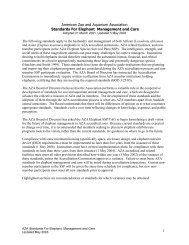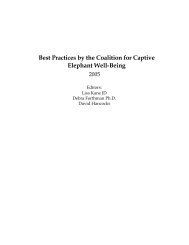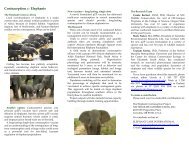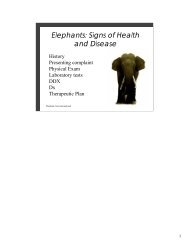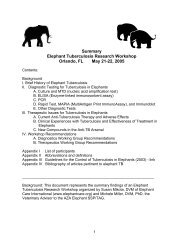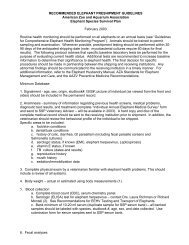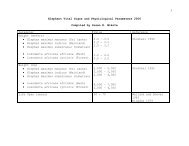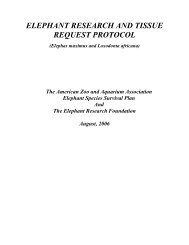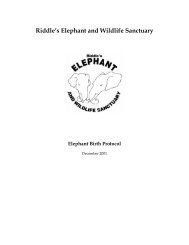Nepal Elephant TB Control and Mgt Action Plan.pdf - Elephant Care ...
Nepal Elephant TB Control and Mgt Action Plan.pdf - Elephant Care ...
Nepal Elephant TB Control and Mgt Action Plan.pdf - Elephant Care ...
- No tags were found...
You also want an ePaper? Increase the reach of your titles
YUMPU automatically turns print PDFs into web optimized ePapers that Google loves.
SummaryThe <strong>Nepal</strong> <strong>Elephant</strong> Tuberculosis (<strong>TB</strong>) <strong>Control</strong> <strong>and</strong> Management Acon <strong>Plan</strong> (NETCMAP) isbased on a goal of minimizing all factors leading to the risk of <strong>TB</strong> transmission from capveelephants to the wild. The program will be launched by the Ministry of Forests <strong>and</strong> Soil Conservaon- Department of Naonal Parks <strong>and</strong> Wildlife Conservaon (DNPWC) with technicalsupport from naonal <strong>and</strong> internaonal conservaon partners including the Naonal Trustfor Nature Conservaon (NTNC) <strong>Nepal</strong>, the Buffer Zone Management Commi ees (BZMCs)<strong>Nepal</strong>, <strong>Elephant</strong> <strong>Care</strong> Internaonal (ECI) USA, World Wildlife Fund (WWF) <strong>Nepal</strong>, <strong>and</strong> theHotel Associaon <strong>Nepal</strong> (HAN). The plan will be implemented under close supervision of aveterinarian with adequate knowledge of animal <strong>TB</strong>.Issues idenfied in capve elephant <strong>TB</strong> control <strong>and</strong> management include: i) Risk of tuberculosisto the capve elephants, ii) Risk of transmission of <strong>TB</strong> from capve to wild populaonof elephants, rhino <strong>and</strong> other wildlife species, iii) Risk of transmission of <strong>TB</strong> from human toelephant <strong>and</strong> from elephant to human, iv) Possibility of impact of <strong>TB</strong> on wildlife tourism in<strong>Nepal</strong>, v) Insufficient technical <strong>and</strong> managerial capacity, vi) Insufficient financial resources,<strong>and</strong> vii) Inadequate research on elephant <strong>and</strong> free ranging wildlife species. A range of acvi-es have been proposed to address these issues.All capve elephants in <strong>Nepal</strong> will be screened for <strong>TB</strong>. Based on diagnosc test results allelephants will be placed in a management group as described in Secon 1.2 <strong>TB</strong> TesngProcedures <strong>and</strong> Management Groups.It is recommended that elephants entering <strong>Nepal</strong> from India must first be screened for <strong>TB</strong>using the <strong>Elephant</strong> <strong>TB</strong> Stat-Pak® test. Only elephants that are non-reacve on the screeningtest should ent er <strong>Nepal</strong>. <strong>Elephant</strong>s that do not have proper documentaon (wri en<strong>and</strong> photograph) from a licensed veterinarian of pre-entry tesng using the <strong>Elephant</strong> <strong>TB</strong>Stat-Pak® test will be tested once they are in <strong>Nepal</strong>. Any elephants that are posive on the<strong>Elephant</strong> <strong>TB</strong> Stat-Pak® test will be required to leave or undergo treatment as described inthis protocol.<strong>Elephant</strong>s will be treated for <strong>TB</strong> according to protocols described in Secon 1.5. All elephanth<strong>and</strong>lers <strong>and</strong> other staff working in close proximity to elephants will be screened annuallyfor <strong>TB</strong> using free services available in <strong>Nepal</strong>. In the case of new elephant h<strong>and</strong>lers, thoroughscreening for <strong>TB</strong> will be undertaken before they begin work with elephants. Annual cerficateswill be issued to facilies in compliance with this program (Appendix II <strong>Plan</strong> Cerficates).




